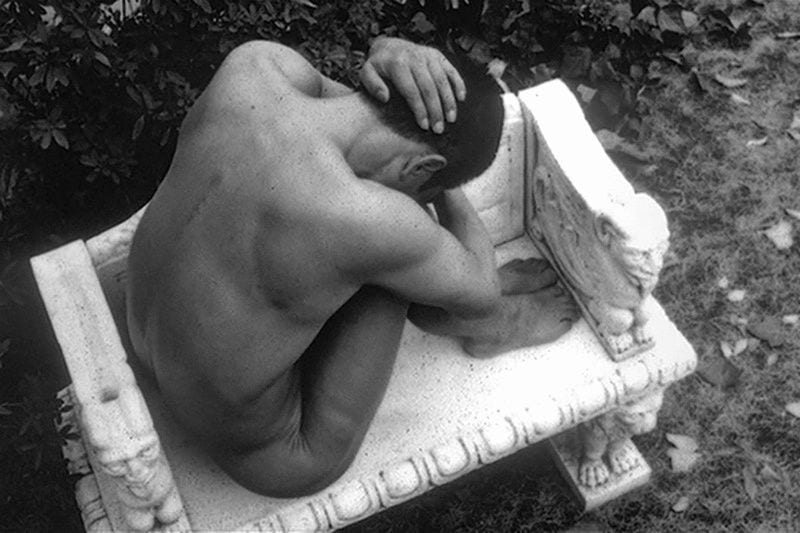
A Life in Four Chapters resonates all the more deeply today, I argue, pronouncing that absurdity. Self-destruction, as I’ve noted in “Fear and Loathing in the Zone: ‘Annihilation’s’ Dreamy ‘Death Drive'”, has become such a regular theme in the age of climate change and spiraling, psychotic domestic politics. The pursuit of an ideal, this drive toward perfection, toward validation and connection, consumes the body (in varying ways, from addiction to overwork to suicide) because the ego doesn’t want any part of its loneliness anymore, its struggle with the very act of living. It doesn’t want to feel ‘less-than-alive’; it doesn’t want to be just dangling there in the turbulent winds of ‘the day-to-day’ (that oft-unbearable torment), unable to resolve the contradictions inherent in the society and thereby inherent in the self and our capitalist social relations. Mishima‘s struggle with his sexual and professional identity cannot help but carry greater impact in an age featuring a listless generation of frustrated professionals and a perhaps greater-than-ever emphasis on respect for personal identity. A Life in Four Chapters, whether then or now, is a masterpiece of modern life.
As is so often the case with widely-regarded masterpieces, A Life in Four Chapters does everything it sets out to do in a manner only film can accomplish with incredible technical prowess and craftsmanship, effectively serving as a paragon for the capabilities of its medium. Despite directly adapting segments from three of Mishima’s major literary works, you could not go out, read those works, and then simply get a sense of A Life in Four Chapters. There’s no analog and no substitute, save – perhaps to the extent Schrader was able to capture it – about the life of Mishima himself.
By detailing the story of his life and his art while revolving around the day of his public seppuku (ritual suicide in the Japanese tradition), Schrader and coscreenwriter Chieko Schrader crafted a film told along three trajectories (as described by Kevin Jackson in his Criterion-included 2008 essay, “Pen and Sword“): the present, or ‘reality’, shot traditionally and detailing the last day of his life; the past, or his memories, shot in excellent and striking black and white photography; and lastly, what can be referred to as ‘imagination’, or brief adaptations of some of his major works shot with the help of production designer and graphic artist Eiko Ishioka in stunning, vibrant dream-like color.
Indeed, A Life in Four Chapters is at times presented very much akin to a dream, and as many of the best directors realize, film is often so much more about presenting a dreamlike-vision to the viewer than trying to ‘realistically’ approximate life itself (not that the latter cannot also be a laudable cinematic aim). This seems to me why some directors become so enraged at the focus on plot holes or missing details in otherwise competent films: dreams do not follow from effect to effect as our lives do. Yours is a floating perspective; you cannot look down at the cameraman’s hands while watching a film as if on a cinematic journey guided by Don Juan.

Indeed, imagine if films did attempt to simply adhere to realism, or had to: we’d certainly have never gotten anything akin to Alejandro Jodorowsky’s The Holy Mountain (1973), or more recently, Nicolas Winding Refn’s Drive (2011) and Denis Villeneuve’s Arrival (2016). Jodorowsky’s attempt to adapt Frank Herbert’s Dune (1965) – as detailed in Frank Pavich’s 2014 documentary literally titled Jodorowsky’s Dune – did not fail because he had a grand and ambitious psychedelic vision for Herbert’s book, which was little interested in being faithful to its source, but rather, found financial ruin over the course of its production at the hands of Jodorowsky’s overzealous spending; it isn’t too far of a stretch to compare dedicated creatives such as Jodorowsky and Mishima, to see similarities in their drive to create at the expense of the practical considerations of the rest of the world (meanwhile, Jodorowsky and Shrader have worked together).
The three aforementioned streams within A Life in Four Chapters – the present (reality), the past (memories), and the fiction (imagination) – progressively ‘mold into’ and ‘catch up’ to one another until they quite literally converge into the moment of his death: the past leads straight to ‘reality’ and the vivid dreamworld of Mishima’s writing comes to precisely mirror the moment of his self-destruction. It ends right there with nothing left to say, because for both Schrader and Mishima, there is nothing left to say even though Mishima’s life and final days leave so many points to ponder (some of which we will explore further).
Schrader communicates Mishima’s art and his life so skillfully and effectively that he ultimately makes it stunningly clear to anyone viewing that Mishima found a way to make the art and the life one, to literally ‘become his art and his art become him’. I’ve described it broadly, but that’s it. Writes Jackson, “Schrader shuffles these varying narrative levels so deftly… that what might sound confusing in outline is always quite clear and utterly compelling.”
Philip Glass‘s mesmerizing and influential minimalist-styled score threads through the film. In a word, it’s amazing. It was Glass’s work which introduced me to A Life in Four Chapters, giving me a sense of almost foreboding in how it might impact me. This has to do with a film Glass would score much later, Errol Morris’s 2003 The Fog of War, a documentary featuring former Secretary of State Robert McNamara near the end of his life. It’s a stunning work which made a serious impact on my early ambitions to become involved in public service (though given McNamara’s dubious reputation among some, due to his role in the Vietnam War, I understand this may seem puzzling).
In The Fog of War, Glass writes a score which, at many points, is deeply reminiscent of his work on A Life in Four Chapters. In particular, “67 Cities” managed to become synonymous in my mind for years with A Life in Four Chapter‘s concluding piece, and in so doing, became deeply associated with those aims toward public service, with a feeling of wanting to live forward in my life in general, to have that ‘sense of being alive’ insofar as I was defining it (to put this another way, imagine a piece of music or art which signals for you a sense of drive in your life). Through Glass, the Kronos Quartet is able to well up these feelings of determination, of the need to seek genuine expression.
There’s no way for me to clearly describe to you what Glass’s work means to me here; it’s a powerful minimalist composition which allows the listener to impart so much of themselves onto it. It reminds me a bit of Beethoven’s Symphony No. 7 in A major, Op. 92, II. Allegretto, but it’s somehow more powerful than that to my ears (not a small claim for anyone to make). It captures something so terribly, terribly sorrowful, but yes, beautiful. I’ve written before about how minimalist compositions can be so striking (“‘On the Nature of Daylight‘: Arrival’s Gentle, Beating Heart”). Glass was my introduction to that. Of all the adoration I have for A Life in Four Chapters, that I consider it to be more than deserving of Glass’s remarkable work is perhaps the most personally resonant praise I can give.
Narrates Mishima early on in A Life in Four Chapters: “In my earliest years, life consisted of two contradictory elements. One was words, which could change the world. The other was the world itself, which had nothing to do with words. For the average person, the body precedes language. In my case, words came first.” The rest of Mishima’s story is his personal, artistic journey toward resolving this dichotomy, toward finding a way to bring his art as a writer to action.
One might pause to consider why Mishima was so set upon this division: is writing not action? Mishima’s understanding of this distinction is not quite literal enough to accept this answer, however: Mishima was seeking a way to feel more alive through his art, to have a visceral experience of living in a world which otherwise alienated him: spoke famed mythologist Joseph Campbell in 1988’s The Power of Myth, “I don’t believe people are looking for the meaning of life as much as they are looking for the experience of being alive” (this series is currently available on Netflix, and I highly recommend it). Mishima’s identity crisis – in part the result of his homosexuality, which A Life in Four Chapters briefly explores as we will see later – is important to the history of modern art in Japan because it in some ways mirrors the social, cultural, and political growing pains of postwar Japan (though more on this later).
Film, of course, has its own way of action, and that medium is ‘the visual’ – the sets, the production elements, the lighting and all of that – and like Mishima, A Life in Four Chapters combines sparse yet impactful narration (the words) with tremendously striking visuals (the action) to produce that union of art and life. It’s clear that Schrader meant to mirror Mishima through his own work of art, even if that work was so thoroughly consumed with the life of another artist. That’s what Mishima’s life demands of you, however, whether you agree with him or not: expression. That artist’s sense of being-in-the-world. From Shrader to Glass to Ishioka, the life of such a ferociously devoted artist seemed to inspire that tremendous expression out of so many involved in the production.
“Words are insufficient.”
In the first chapter, we strum along to a rather militaristic-sounding composition from Glass while Mishima (Ken Ogata) rises from bed and begins his day in a very deliberate fashion. Throughout A Life in Four Chapters, Schrader offers us snippets of Mishima’s autobiography Sun and Steel: Art, Action and Ritual Death (Kodansha International,1968, translated by John Besterand published in the states in 2003 by Kodansha USA). These are always brief, but owing to the late writer’s talent, never anything less than impactful: “Recently I’ve sensed an accumulation of many things which cannot be expressed by an objective form like the novel. Words are insufficient. So, I found another form of expression.”
Mishima dons a smart and very traditional looking military uniform before leaving his room. From here, memories are laced into reality seamlessly. As he departs for his mission, we see a boy in the window. It’s Mishima. Cut to black and white. “When I examine my early childhood, I see myself as a boy leaning at the window… forever watching a world I was unable to change, forever hoping it would change by itself.” The young boy is then called by his grandmother (who took Mishima away from his mother as an infant).
The relationship presents immediately as toxic; Mishima’s grandmother coops him up in her home and attempts to guilt the boy for wanting to reunite with his mother. “Only you can make grandma feel better,” and as he begins to cry, she asks him to massage her legs (which he proceeds to do in a scene which is altogether awkward). You later see the two of them out in public. Mishima’s grandmother detests the ‘modern’ crowd: “Don’t apologize to these commoners! … When I was a girl, people still had a modicum of manners.” Implied here is the distinction between pre-and-postwar Japanese culture; we see the seeds, perhaps, of the kind of nationalism Mishima would exude towards the end of his life.
Schrader’s work has this way of subtly introducing all of its themes at once from the very beginning. While it would perhaps be tempting for some directors to make a confusing mess of a film out of a life as complex as Mishima’s within the pretense of some misguided notion of artistic depth, Shrader and company must be commended for an incredibly clear presentation of what could have easily been labyrinthine, overwrought, and pretentious. Self-destruction, lust, nationalism, identity, the struggle for genuine expression… it is all right there, and you are simply along for the ride to watch it unfold.
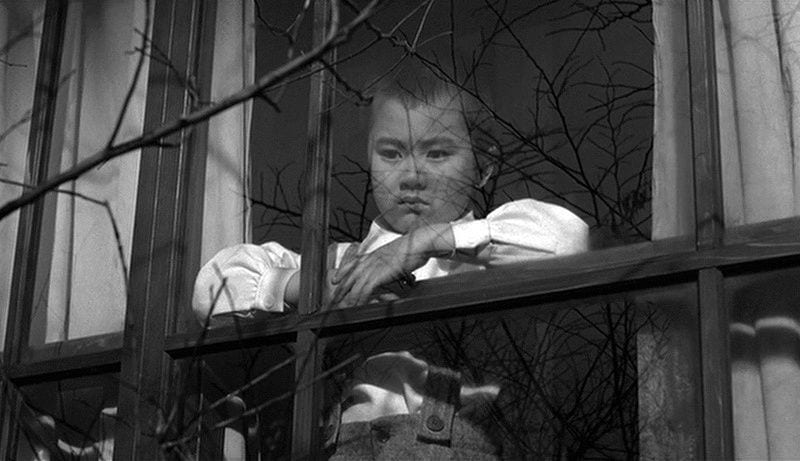
Mishima’s The Temple of the Golden Pavilion (Shinchosha, 1956) is the first of the three adaptations of the writer’s work. The lead, Mizoguchi (Yasosuke Bando), is walking with his crippled friend Kashiwagi (Kôichi Satô) near the ‘Golden Pavilion’. Though not a detail given explicitly within A Life in Four Chapters, Mizoguchi is the stuttering child of a Buddhist priest who instills in him the notion that the Golden Pavilion is the height of beauty. Mizoguchi is captured by this in a way, by this very concept of beauty, and struggles with it throughout (a struggle intimately tied with his grave stuttering).
Mizoguchi’s difficult and consuming preoccupation with beauty mirrors the young Mishima’s real-world obsession with the image of the martyred Saint Sebastian: “Suddenly I came across a picture whose only purpose had been to lie in wait for centuries and ambush me. The white matchless beauty of the youth’s body hung against the tree trunk… I trembled with joy. My loins swelled… My need to transform reality was an urgent necessity, as important as three meals a day or sleep.” Mishima seems to write some of his frustration with this lust for beauty, this need to transform his reality, this being trapped by it, through Mizoguchi: “[The Pavillion] filled the world… like tremendous music. That’s the p-p-power… of beauty’s eternity. It poisons us. It blocks out… our lives… Beauty is now my enemy. Life is b-b-bearable only when I imagine the G-Golden Pavilion has been destroyed… The American b-b-bombers will come. Then… I’ll be free.” It is because Mishima considers the ultimate expression of beauty to be contained within the body itself that Mizoguchi’s urge to destroy the Golden Pavilion could be read as an early expression of Mishima’s self-destructive artistic drives.
In part two we see Mishima grown and enjoying his newfound success as a successful writer. He wears fine Western clothing and looks plain handsome. It’s here in particular where it becomes rather clear that Mishima’s story, not unlike postwar Japan itself, so mirrors aspects of Western life. He’s consumed by his work: “Every night I return to my desk precisely at midnight. I thoroughly analyze why I am attracted to a particular theme. I drag it into my conscious mind. I boil it into abstraction. I am constantly calculating until I sit down to write. Only then can my unconscious dreams take over.”
The next adaptation is Mishima’s 1959 Kyoko’s House (original publisher presumably Shinchosha; generally unavailable in the US until published again in 2016 by Amazon Digital Services LLC). This is perhaps my favorite. The whole film is gorgeous, but here the use of color is simply flooring (and somewhat reminiscent of ’80s and ’90s consumer Japan – which has become marginally re-popularized in the West through the emergence of ‘vaporwave‘ – though it should be noted that the actual time period is indeed the ’50s). Of the novel’s two leads, Schrader focuses on the actor rather than the boxer, slickly portrayed by Kenji Sawada. The actor decides that he will take up bodybuilding in the pursuit of beauty. Cutting back and forth between the black and white past, we see Mishima pursue bodybuilding as well, intent on sculpting himself into the image of his beatific martyr: “What I lacked was health – a healthy body, a physical presence. Words had separated me from my body… I saw that beauty and ethics were one and the same. Creating a beautiful work of art and becoming beautiful oneself are identical.” In a photo shoot, he mimics the very posture of the martyred saint, made to look as if pierced three times with arrows.
In an effort to get his mother ( Reisen Ri) out of a bad deal with a loan shark, the actor meets up with a woman named Mitsuko (Setsuko Karasuma) to negotiate a deal. After a rather odd kind of flirting, Mitsuko makes an unusual offer: she will resolve his mother’s debts if he ‘sells himself’ over to her ‘life and body’. Basically, she wants to own him, the ultimate objectification. The actor smirks. His body is recognized as an ‘object’ of beauty in a way he had been deeply yearning for. What proceeds is a sadomasochistic relationship which sees the two of them inch closer and closer to their idealized beauty until, finally, Mitsuko kills the actor and then commits suicide via a bottle of poison labeled ‘Peace’. This actualizes a previous scene in Kyoto House, where the actor and two other artists debate what the human body means to art: “The human body is a work of art. It doesn’t need artists.” One of the party, a landscape painter, counters by noting that the body decays and dies. “Where is beauty then? Only art makes the human beauty endure. You must devise an artists’ scheme to preserve it. You must commit suicide at the height of your beauty.”
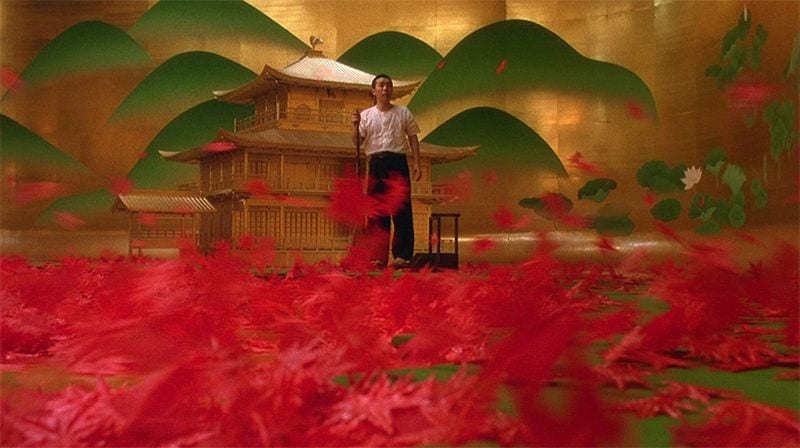
This concept – of killing yourself at the ‘height of your beauty’ so as to in some way ‘preserve’ it – is espoused by Mishima himself both in his adoration of the martyred saint and through his relationships with other men. Indeed, it’s plainly suggested that Mishima’s self-destructive obsession with beauty is deeply tied to his identity as a homosexual. In a cut to the past, we see Mishima watching some men dance prior to his foray into body building: “I also wear a mask. I also play a role. When he looks in the mirror, the homosexual, like the actor, sees what he fears most: the decay of the body.” When later dancing himself, his partner makes an innocent joke about him looking a little ‘flabby’. Mishima takes great offense, and leaves. When his partner later insists upon an explanation, Mishima relents with considered unease: “Both you and I have a strong sense of aesthetics. When you look in the mirror, you see beauty. I can’t even look at myself. So, don’t make jokes like that again.”
The difficult and contentious way in which Mishima grapples with his sexual identity constitutes one of the main ways in whichA Life in Four Chapters remains so relevant today. Writes Nick Arnold for the BBC in a 2018 piece titled “How being a gay man can make your body issues worse”, he describes the torturous ways in which some gay men relate to their own bodies: “Body image is an issue for many men, regardless of sexuality. But it seems to be more of a problem in the gay community. When it comes to appearance, gay men hold themselves — and one another – to far more exacting standards. I spoke to a few men anonymously about this on Grindr. As one told me, “what’s seen as normal in straight men isn’t the same with gay men. You can be ‘straight thin’, but ‘gay fat’.”‘
In a rather heart-breaking account by David Leveseque, a gay vlogger interviewed by Arnold, he describes how society’s often middling acceptance of homosexuality feeds these issues with self-image: “‘I’ve definitely had an unhealthy relationship with my own body in the past… Part of the obsession some gay men have with their appearance definitely comes from seeking validation… Gay people often don’t feel accepted. But, the thinking goes, if people think you’re good looking, they like you. They look past your sexual orientation.”‘ I feel these sentiments go some way to help explain the experiences of men like Mishima, to explain what might have driven him to such obsession, both with beauty as a concept and as actualized through his intense dedication to physical perfection.
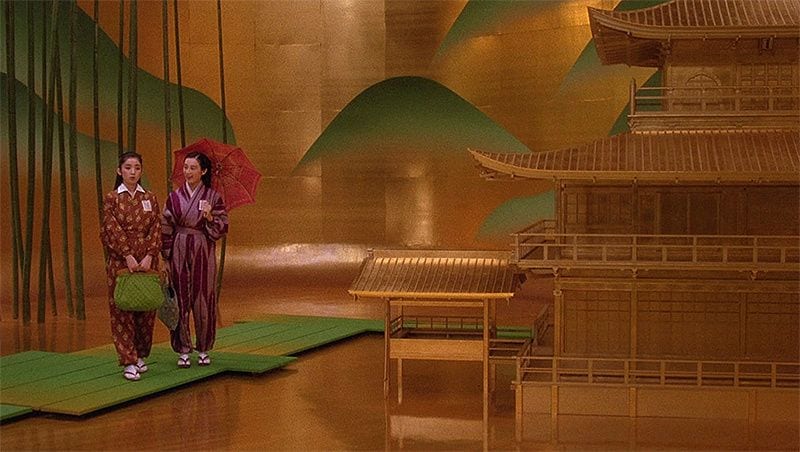
This also may help to explain Mishima’s later preoccupation with some of the aesthetics of feudal and prewar Japan, namelybushidō and the samurai. In Gary Leupp’s Male Colors: The Construction of Homosexuality in Tokugawa Japan (University of California Press, 1997), he describes the relationship young men had with their older teachers (sensei) as samurai in training, engaging in sexual intercourse if the novice agreed to it (p. 51). The acceptance of homosexual activity in Tokugawa Japan is described plainly in the preface as “[ranking] with Athens as a society that not only tolerated, but celebrated, male homosexual behavior.”
These were attitudes which would subside as Japan industrialized, and in postwar Japan, struggles with acceptance of homosexual behavior would often mirror (or even be worse than) Western nations: as recently as 2016, a report by the Agence France-Presse published in the South China Morning Post describes discrimination as a serious and ongoing issue in Japan which “lags behind the United States and many other Western nations in terms of gay rights and same-sex marriage.” The report continues: “‘Hateful anti-LGBT rhetoric is nearly ubiquitous in Japanese schools, driving LGBT [lesbian, gay, bisexual and transgender] students into silence, self-loathing, and in some cases, self-harm,’ [Human Rights Watch] said.”
It’s as A Life in Four Chapters nears its conclusion that Mishima’s growing nationalism and preoccupation with traditional Japanese military culture announces itself. Suitably, the final adaptation is of Runaway Horses (originally Shinchosha in 1969, then Alfred A. Knopf in 1973 for English-speakers). The second in Mishima’s ‘Sea of Fertility’ tetralogy, it concerns a young man named Isao who is skilled in swordsmanship (Toshiyuki Nagashima). He practices his art in a dojo; we see the standard of the Rising Sun set across the far wall, katanas adorned at its feet. Like the other two leads we’ve been introduced to, Isao is consumed with an idea – in this case, Japan’s ‘soul’, it’s ‘purity’. He has a scheme along with several fellow swordsmen to commit multiple assassinations in cooperation with the military. “Japan will be purified.” When we return to Mishima in the past, he sits alone in a dojo, adorned in traditional garb with a real sword at his waist.
By now, that ‘past’ is rapidly catching up to the final day of Mishima’s life. Mishima and Isao’s struggles altogether mirror one another plainly as can be. Mishima’s aforementioned dive into the far-right politics of the time is right there in Isao: “One: We vow to go forth to purge our nation of capitalist evils. Two: We hereby vow to forge eternal friendship among ourselves. Three: We hereby vow to restore His Imperial Majesty.”
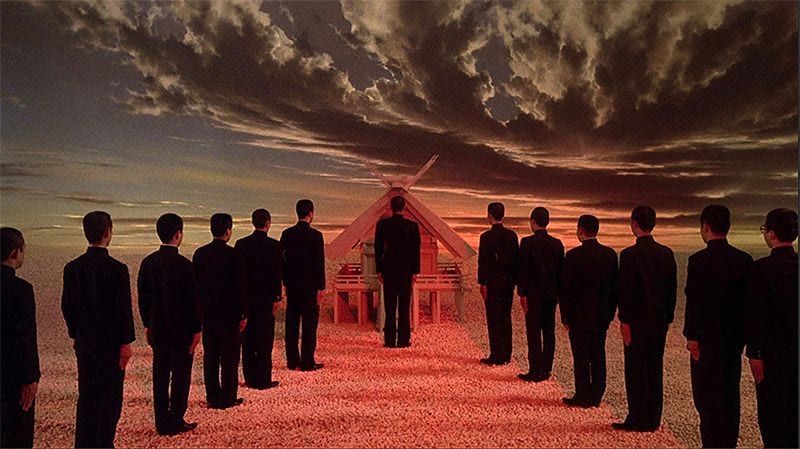
Mishima, sitting with the young soldiers of his real life private army (the ‘ Shield Society‘), recites an effectively identical pledge which they then collectively seal with blood oaths. The notion of purity, of Japan’s purity, the purity of the emperor and the way of life prior to Japan’s postwar capitalist development, becomes central to Mishima. Speaking to a crowd with his soldiers in tow, he describes his aims: “Our goal is to restore the noble tradition of the way of the samurai. I have always supported the tradition of elegant beauty in Japanese literature. I cannot stop striving to unite these two great traditions.” He speaks to the Westerners present in his best English: “We are a spiritual army, dedicated to purity. We oppose the corruption and modernization of the Japanese spirit both from the right and the left.” For Japan’s far-right, this meant a rejection of Western capitalism and other Western cultural modes.
The notion of purity is always very telling in right-wing or otherwise partisan discourses, and it’s not at all foreign to far-right groups in America such as white supremacist, nativist, and/or nationalist movements (though tests of ideological rigor are common to groups across the political spectrum, including, for example, certain hard-leaning Communist organizations). I’m reminded of anthropologist/cultural theorist Mary Douglas’s 1966 sociological analysis of ‘purity and danger’ ( Purity and Danger: An Analysis of the Concepts of Pollution and Taboo, New York, NY: Routledge), or the discursive functions of ‘pollution’ and ‘taboo’ within an ideological framework. Similarly, J.D. Atkinson and Leon Berg’s 2012 analysis of alternative right-leaning media found an ordering of group membership within a framework of ‘purity’ (Narrowmobilization and Tea Party Activism: A Study of Right-Leaning Alternative Media. Communication Studies, 63(5), pp.519–535). In other words, how important and honored you were within the group was determined by the magnitude of your single-minded dedication to the group’s ideals; ‘purity’ suggests a lack of deviation, an unwillingness to question core beliefs.
In other words, in fringe groups such as those found on the far-right of a given nation’s political spectrum (though we should be very careful not to think of all far-right groups as essentially the same, or even similar), one’s ‘authentic being’ within the organization is seen as a function of their degree of that ideological purity. We might conjecture that Mishima was drawn to this for reasons atypical of many members of the far-right; his single-pointed pursuit of his art, of beauty, compels him to these stark notions of purity. Mishima seems to conclude he can encounter a ‘real sense of being alive’ via this pursuit of purity which allows him to merge his art with the visceral experiences of the body, experiences which he feels the military allows him to express. When we see Mishima going to speak with a group of protesting Leftist students at Tokyo University, he recounts his bliss at the opportunity to enact these ideals in the political sphere to an audience: “For a moment I felt I was entering the realm where art and action convert. For a moment I felt alive.” He does not go to the university to attack or belittle the students, but to attempt to persuade him to his vision, to bridge a gap where the shared concern could be Japan’s identity and well-being.
“A line of poetry written with a splash of blood.”
Writes Mishima in Runaway Horses, “Perfect purity is possible if you turn your life into a line of poetry written with a splash of blood.”
We’ve discussed how A Life in Four Chapters so ably captures such a tremendously complex life as Yukio Mishima’s. We’ve noted how his struggles with identity and political expression continue to ring resolutely – if contentiously – today. The contradictions Mishima experienced – whether between the ‘word’ and the ‘body’, the ‘novel’ or ‘action’, or pre-and-postwar Japan – were contradictions which tore at Mishima until he quite literally tore himself apart. Yet, at the end of it, he stood for this kind of artistic expression even some of the most ardent, dedicated creatives only darkly dream of, only wish for.
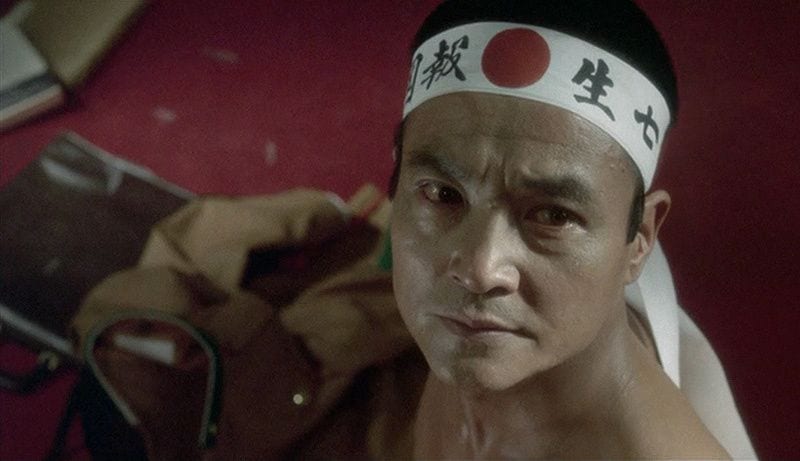
Words, yes, were so much a part of Mishima’s life, but he felt an encompassing lack, the urge toward action, toward the body and toward the unification of his ‘selves’, the ultimate expression of that ‘art’. Mishima was caught between the past and the modernization of both Japan and the rest of the postwar world with it, two halves he could not reconcile. We are today faced with dire social needs and demands, both political and economic, which cannot be reconciled while under the mounting contradictions of capitalist domination, of neoliberalism. The trends in social relations, which so much began in the postwar era, have only grown in those contradictions, demanding more and more of people faster and faster before most of us can sort out what the hell is happening. We can’t get our bearings. We can’t find where we lie, and we certainly don’t know how to express whatever it is that we are supposed to be when the façade falls away.
It may seem trite, idealistic, or simplistic, but perhaps Yukio Mishima’s life would have taken a different path if he could have been more certain that he was loved, that he could express himself as he truly identified with the sound expectation of real acceptance from others. As is so often the case with the struggles faced by marginalized groups, it can be very difficult for outside observers to understand just how much all the little ways in which one feels ostracized might build to a trembling crescendo of self-hate, doubt, and destruction.
A Life in Four Chapters is an example of an artistic expression so compelling that it – perhaps particularly for more distant Western observers – transcends many of the complex, difficult, and politically-charged circumstances which surrounded it. Mishima’s life was itself a modern testament to the expressive potential of human life in our present circumstances, choices you don’t necessarily need to agree with to come into some contact with that profound art. You only need to watch, then perhaps consider how you might ever find that clear feeling that you exist, if only for a moment.
Paul Schrader‘s Mishima: A Life in Four Chapters (1985, hereafter referred to as A Life in Four Chapters) depicts some of the defining moments of mega-famous late Japanese author Yukio Mishima’s (hereafter ‘Mishima’) life – including the life of his ‘fictional’ characters – via some of cinematic history’s most brilliant and naked visual expressions. Ken Ogata portrays Mishima with charisma to spare, and similar to everything else he’s done, is never anything less than immersively compelling.
In a 2008 article written for A Life in Four Chapters’ Criterion release (author unspecified), the controversy surrounding the film’s initial release is detailed: “To this day, [A Life in Four Chapters] has never been released in its subject’s homeland, despite the fact that it was made there… opposition to the film sprang just as much from almost the opposite sentiment [to disavowment, coming rather from] a reverence for the man, [even] at his most notorious.” The author describes Mishima’s late ultra-nationalism and the fervor this inspired in Japan’s small, factionalized far-right: “These groups objected to the appropriation of their hero, especially by a non-Japanese director, and threatened violence against those who had anything to do with the film.” These threats extended to the events surrounding the 1985 Tokyo International Film Festival, where A Life in Four Chapters was rejected for fear of threats from right-wing extremists, a decision which attracted international outrage.
Despite being one of the most remarkable films produced in a nation whose directors seem to make up a sizable chunk of Criterion’s entire film collection (Akira Kurosawa’s 1956 Ikuru was made here – perhaps my very favorite film – while Kurosawa himself has had 24 films added to the Criterion Collection), A Life in Four Chapters was taboo in its own country. Stunningly. Another chapter in an absurd world.
- 'On the Nature of Daylight': Arrival's Gentle, Beating Heart - PopMatters
- Losing the Narrative of Your Life: On Alissa Quart's'Squeezed
- Fear and Loathing in the Zone: 'Annihilation's' Dreamy 'Death Drive ...
- Vengeance Is Mine - PopMatters
- High Moon: The Japanese Western - PopMatters
- Dear God I Love Xiu Xiu
- Slave Widow - PopMatters
- Junichiro Tanizaki's 'Naomi' Than Vladimir Nabokov's 'Lolita ...
- 'Forbidden Colors' Shades of Conformity, Manipulation ...
- The Stories In 'Acts of Worship' Feel Like Practice Runs for Better ...
- Yukio Mishima, of Love and Death - PopMatters

